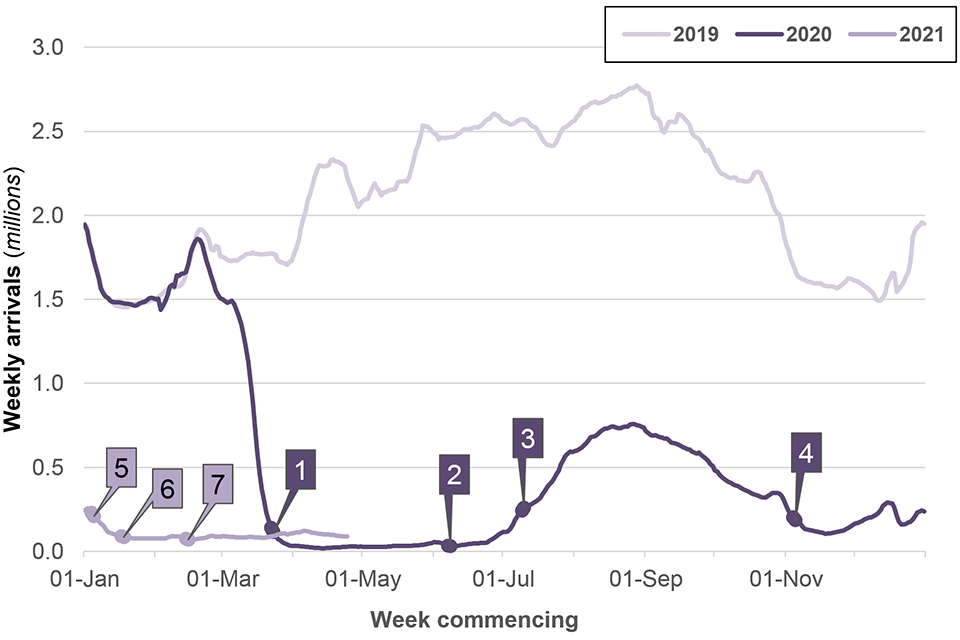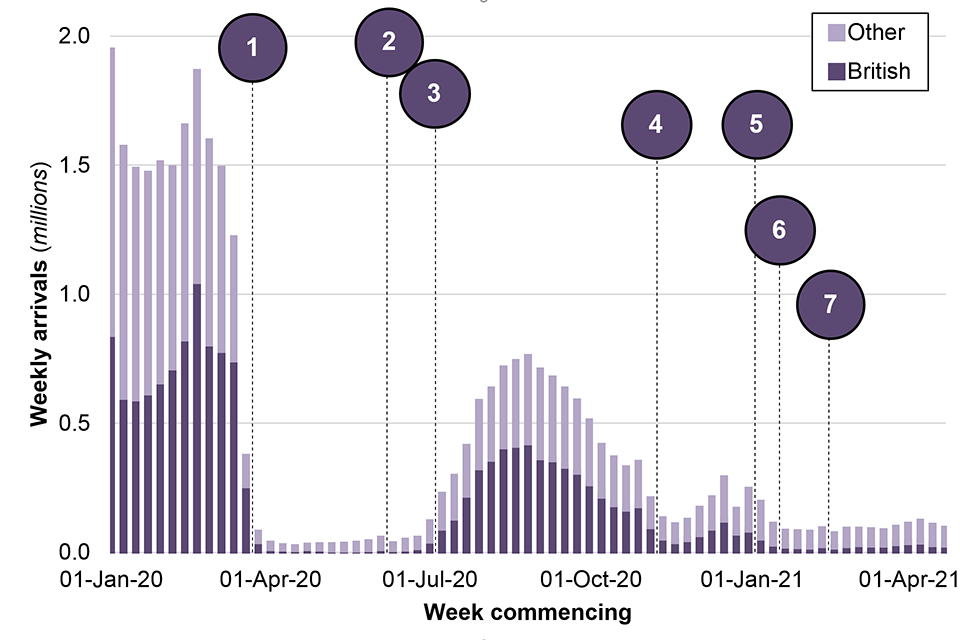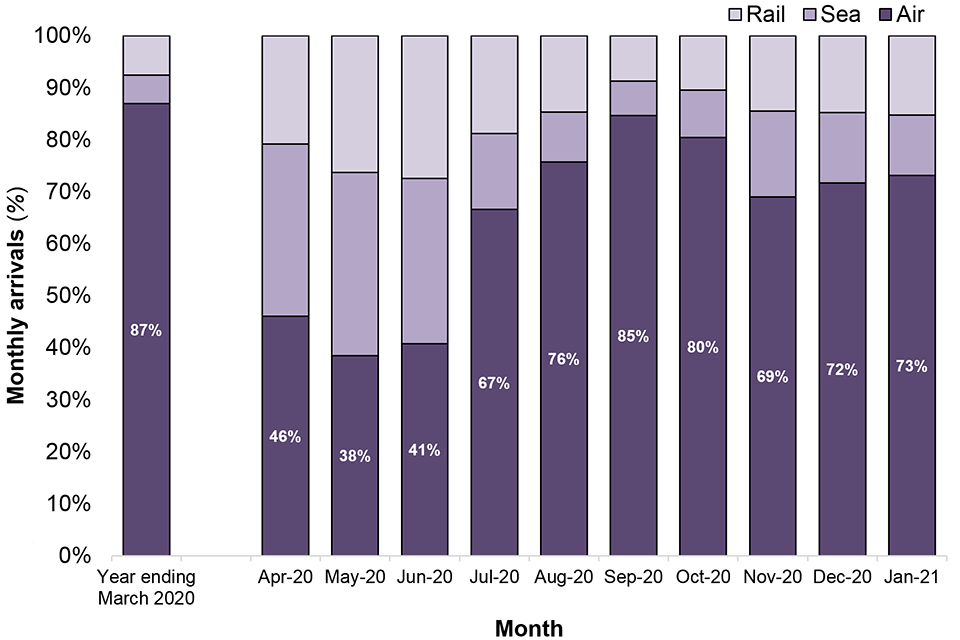Statistics relating to passenger arrivals since the COVID-19 outbreak, May 2021
Published 27 May 2021
1. Passenger arrivals
This release presents experimental statistics on passenger arrivals between 01 January 2019 and 30 April 2021. This report focuses on comparisons between the pre- and post-COVID-19 period (using 2019 as the baseline for comparisons), examining the impact of the COVID-19 outbreak on numbers of air passenger arrivals in the UK. More information on the data sources and limitations can be found in the ‘about the data’ section.
The Home Office publishes data on the total number of passenger arrivals to the UK in the Immigration Statistics. However, this does not include detailed breakdowns (such as nationality or route) for arriving passengers. The data published here is not directly comparable with the passenger arrivals data in the Immigration Statistics, as it comes from different sources. Further work is underway to investigate the quality of other data sources for producing estimates of UK arrivals.
2. Key findings
There were 447,300 air passenger arrivals to the UK in April 2021 (from Advanced Passenger Information (API) data). This is four times (298%) higher than the total number of air arrivals for April 2020, immediately following the start of the first UK lockdown, when there were 112,300 arrivals. However, this remains around 5% of the number of arrivals in April 2019 (9,120,400).
The numbers in every month since April 2020 remain substantially lower than levels seen prior to the COVID-19 outbreak in the UK, averaging 89% lower over the 12 months following the onset of the pandemic.
Figure 1: Weekly air passenger arrivals to the UK, Jan 2019 - Apr 2021

Source: Air passenger arrivals data tables
Figure 1 shows that there were fewer than 200,000 air arrivals per month between April and June 2020, following the start of the first UK lockdown. There was a slight increase in the summer months of 2020, reaching a summer high of 3.1 million arrivals in August, still 74% lower than the figure for August 2019. The number of air arrivals subsequently decreased again with fewer than 500,000 air arrivals per month in February to April 2021. This is due to a combination of tightening restrictions towards the end of 2020 and the typical seasonal patterns in arrivals which are lower in winter months.
The charts in this report show the key dates which are likely to have had an impact on passenger arrivals to the UK, either through restrictions on travel, or requirements in place for those who do travel.
- 23 March 2020: UK first lockdown announced.
- 08 June 2020: Health measures introduced at the border. This relates to a series of measures that are designed to prevent new cases of Covid-19 being brought in from abroad.
- 10 July 2020: International Travel Corridors introduced. Passengers arriving from specific countries advised that they will not need to self-isolate when arriving in England.
- 05 November 2020: Second national lockdown in England starts.
- 05 January 2021: Third national lockdown in England starts.
- 18 January 2021: Travellers from abroad required to show proof of a negative Covid-19 test. International Travel Corridors suspended, meaning all travellers from outside the UK, Ireland, Channel Islands and Isle of Man need to self-isolate for 10 days after arriving in the UK.
- 15 February 2021: Introduction of Managed Quarantine, which requires arrivals to England from “red list” countries, from British or Irish nationals or residents of the UK, to book an isolation package at a government approved facility.
Additional contributing factors will include the individual restrictions imposed by each of the devolved administrations and travel bans to or from the UK from different countries.
Typically, around half of air passenger arrivals in the UK are British nationals (although this can fluctuate from month to month). The other arrivals will include foreign nationals who are UK residents returning to the UK, non-British dependants of UK residents, and other non-British nationals including those who are visiting or working in the UK.
Figure 2: Weekly air passenger arrivals to the UK, by nationality, Jan 2020 – Apr 2021

Source: Air passenger arrivals data tables
Figure 2 shows that the proportion of arrivals that were British nationals rose slightly in the weeks immediately before and after the UK lockdown was announced (23 March 2020), when air passenger arrivals began to fall significantly. This was followed by a large fall in the proportion of British nationals between May and early July 2020, before increasing again to 57% for August 2020. This proportion has fallen again since and British nationals made up less than 40% of arrivals between January and April 2021, which is lower than the equivalent months for 2019 and 2020.
Table 1: Passengers arriving to the UK by air, compared with the same month in 2019
| Air arrivals | % of whom: British nationals | % change in total arrivals compared with same month in 2019 | |
|---|---|---|---|
| January 2020 | 7,082,000 | 41% | +1% |
| February 20201 | 6,804,900 | 51% | -2% |
| March 2020 | 3,815,300 | 58% | -51% |
| April 2020 | 112,300 | 56% | -99% |
| May 2020 | 139,300 | 36% | -99% |
| June 2020 | 194,900 | 34% | -98% |
| July 2020 | 1,260,400 | 49% | -89% |
| August 2020 | 3,106,500 | 57% | -74% |
| September 2020 | 2,757,700 | 53% | -75% |
| October 2020 | 1,741,100 | 53% | -82% |
| November 2020 | 690,600 | 46% | -90% |
| December 2020 | 895,000 | 44% | -88% |
| January 2021 | 631,500 | 32% | -91% |
| February 2021 | 319,200 | 31% | -95% |
| March 2021 | 386,600 | 36% | -95% |
| April 2021 | 447,300 | 34% | -95% |
| Year Ending March 20212 | 12,235,100 | 50% | -89% |
Source: Air passenger arrivals data tables
Notes
- In order to ensure the February 2020 comparison with February 2019 compares the same number of days, arrivals on the 29 February 2020 are excluded from the ‘% change with the same month in 2019’ column but are included in the total number of arrivals for that month.
- Comparisons for the Year Ending March 2021 are with the 12 months between January and December 2019.
- Totals in the table may not equal the sum of individual days in the accompanying air passenger arrivals data table due to rounding.
Additional data drawn from Border and Immigration Transactions data (BITD) can be used to illustrate the proportion of arrivals through the air, sea and rail routes – although numbers of transactions will not accurately reflect the total number of individuals arriving due to the way in which systems operate at the border. The BITD figures in this report cover the period between April 2019 and January 2021 Due to the ongoing development of new borders systems, data for the period February to April 2021 are currently unavailable but will be provided in future publications.
Figure 3: Monthly arrivals, by percentage arriving by air, sea and rail, year ending March 2020 and April 2020 to January 2021

Source: BITD data
Figure 3 shows that passengers arriving by air accounted for 87% of all passenger arrivals (across all routes) to the UK in the year ending March 2020.
Following the introduction of the first UK lockdown this proportion fell to 38% by May 2020, as air arrivals fell more sharply than rail and sea arrivals. The number of air passenger arrivals increased over the summer months and represented 85% of all arrivals by September 2020, although the total number of arrivals remained far below pre-pandemic levels. Since then, air passenger arrivals have decreased, although the proportion of air arrivals increased slightly between November 2020 and January 2021, accounting for 73% of air arrivals in January 2021 (BITD data).
The number of arrivals across all routes (air, rail and sea) from April 2020 were considerably lower than the equivalent month in the year ending March 2020. The falls were largest in April and May 2020, around the time of the first lockdown in the UK (all routes had reduced by 87-99% in April). The number of arrivals were higher over the summer months but decreased again subsequently. In the latest month where data are available, January 2021, air arrivals stood at around 9%, rail arrivals around 20% and sea arrivals 27% of their January 2020 levels.
Table 2: Percentage change in arrivals for April 2020 to January 2021 compared with same month in the year ending March 2020, by route
| Month | Air arrivals | Sea arrivals | Rail arrivals |
|---|---|---|---|
| April 2020 | -99% | -87% | -94% |
| May 2020 | -99% | -81% | -89% |
| June 2020 | -98% | -77% | -84% |
| July 2020 | -90% | -69% | -65% |
| August 2020 | -76% | -65% | -50% |
| September 2020 | -76% | -66% | -66% |
| October 2020 | -84% | -70% | -77% |
| November 2020 | -91% | -51% | -79% |
| December 2020 | -89% | -61% | -76% |
| January 2021 | -91% | -73% | -80% |
| April 2020 to January 2021 | -89% | -71% | -75% |
Source: BITD data
3. About the data
Data on passenger arrivals are derived from live operational systems; Advance Passenger Information (API), and Border and Immigration Transaction Data (BITD). These data are not designed for statistical purposes, there are known issues in producing estimates of arrivals from these sources and the data sources are not directly comparable.
API data primarily relate to passengers coming to the UK via commercial aviation routes. The data do not include those arriving by sea or rail routes, by private aircraft or via the Common Travel Area (CTA). Figures for more recent periods in particular, may also be subject to revision.
BITD data relate to those coming to the UK on air, sea, and rail routes, but does not include those coming via the CTA. As the system was not designed for statistical purposes, the data should be considered indicative. Some passengers will be counted multiple times in the data where more than one interaction has occurred. Data from the year ending March 2020 is the earliest available for reporting purposes. The impact of COVID-19 will affect March 2020 data to some degree.
Data from the API on the number of passengers arriving by air are published in the accompanying air passenger arrivals data tables.
